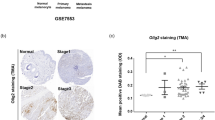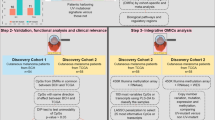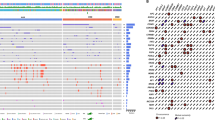Abstract
The occuloalbinism 2 (OCA2) gene, localized at 15q11, encodes a melanosomal transmembrane protein that is involved in the most common form of human occulo-cutaneous albinism, a human genetic disorder characterized by fair pigmentation and susceptibility to skin cancer. We wondered whether allele variations at this locus could influence susceptibility to malignant melanoma (MM). In all, 10 intragenic single-nucleotide polymorphisms (SNPs) were genotyped in 113 patients with melanomas and in 105 Caucasian control subjects with no personal or family history of skin cancer. By comparing allelic distribution between cases and controls, we show that MM and OCA2 are associated (p value=0.030 after correction for multiple testing). Then, a recently developed strategy, the ‘combination test’ enabled us to show that a combination formed by two SNPs was most strongly associated to MM, suggesting a possible interaction between intragenic SNPs. In addition, the role of OCA2 on MM risk was also detected using a logistic model taking into account the presence of variants of the melanocortin 1 receptor gene (MC1R, a key pigmentation gene) and all pigmentation characteristics as melanoma risk factors. Our data demonstrate that a second pigmentation gene, in addition to MC1R, is involved in genetic susceptibility to melanoma.
Similar content being viewed by others
Log in or create a free account to read this content
Gain free access to this article, as well as selected content from this journal and more on nature.com
or
References
Dreno B, Wallon-Dumont G : Epidemiology of melanoma. Presse Med 2003; 32: 30–32.
Kamb A, Shattuck-Eidens D, Eeles R et al: Analysis of the p16 gene (CDKN2) as a candidate for the chromosome 9p melanoma susceptibility locus. Nat Genet 1994; 8: 23–26.
Hussussian CJ, Struewing JP, Goldstein AM et al: Germline p16 mutations in familial melanoma. Nat Genet 1994; 8: 15–21.
Zuo L, Weger J, Yang Q et al: Germline mutations in the p16INK4a binding domain of CDK4 in familial melanoma. Nat Genet 1996; 12: 97–99.
Holland EA, Schmid H, Kefford RF, Mann GJ : CDKN2A (P16(INK4a)) and CDK4 mutation analysis in 131 Australian melanoma probands: effect of family history and multiple primary melanomas. Genes Chromosomes Cancer 1999; 25: 339–348.
Palmer JS, Duffy DL, Box NF et al: Melanocortin-1 receptor polymorphisms and risk of melanoma: is the association explained solely by pigmentation phenotype? Am J Hum Genet 2000; 66: 176–186.
Kennedy C, ter Huurne J, Berkhout M et al: Melanocortin 1 receptor (MC1R) gene variants are associated with an increased risk for cutaneous melanoma which is largely independent of skin type and hair color. J Invest Dermatol 2001; 117: 294–300.
Matichard E, Verpillat P, Meziani R et al: Melanocortin 1 receptor (MC1R) gene variants may increase the risk of melanoma in France independently of clinical risk factors and UV exposure. J Med Genet 2004; 41: e13.
Lee ST, Nicholls RD, Bundey S, Laxova R, Musarella M, Spritz RA : Mutations of the P gene in oculocutaneous albinism, ocular albinism, and Prader–Willi syndrome plus albinism. N Engl J Med 1994; 330: 529–534.
Ramsay M, Colman MA, Stevens G et al: The tyrosinase-positive oculocutaneous albinism locus maps to chromosome 15q11–q12. Am J Hum Genet 1992; 51: 879–884.
Staleva L, Manga P, Orlow SJ : Pink-eyed dilution protein modulates arsenic sensitivity and intracellular glutathione metabolism. Mol Biol Cell 2002; 13: 4206–4220.
Gardner JM, Nakatsu Y, Gondo Y et al: The mouse pink-eyed dilution gene: association with human Prader–Willi and Angelman syndromes. Science 1992; 257: 1121–1124.
Bianchi AB, Fischer SM, Robles AI, Rinchik EM, Conti CJ : Overexpression of cyclin D1 in mouse skin carcinogenesis. Oncogene 1993; 8: 1127–1133.
Rinchik EM, Bultman SJ, Horsthemke B et al: A gene for the mouse pink-eyed dilution locus and for human type II oculocutaneous albinism. Nature 1993; 361: 72–76.
Rosemblat S, Sviderskaya EV, Easty DJ et al: Melanosomal defects in melanocytes from mice lacking expression of the pink-eyed dilution gene: correction by culture in the presence of excess tyrosine. Exp Cell Res 1998; 239: 344–352.
Orlow SJ, Brilliant MH : The pink-eyed dilution locus controls the biogenesis of melanosomes and levels of melanosomal proteins in the eye. Exp Eye Res 1999; 68: 147–154.
Hirobe T, Kawa Y, Mizoguchi M, Ito S, Wakamatsu K : Effects of genic substitution at the pink-eyed dilution locus on the proliferation and differentiation of mouse epidermal melanocytes in vivo and in vitro. J Exp Zool 2002; 292: 351–366.
Ozeki H, Ito S, Wakamatsu K, Hirobe T : Chemical characterization of hair melanins in various coat-color mutants of mice. J Invest Dermatol 1995; 105: 361–366.
Tamate HB, Hirobe T, Wakamatsu K, Ito S, Shibahara S, Ishikawa K : Levels of tyrosinase and its mRNA in coat-color mutants of C57BL/10J congenic mice: effects of genic substitution at the agouti, brown, albino, dilute, and pink-eyed dilution loci. J Exp Zool 1989; 250: 304–311.
Lamoreux ML, Zhou BK, Rosemblat S, Orlow SJ : The pinkeyed-dilution protein and the eumelanin/pheomelanin switch: in support of a unifying hypothesis. Pigment Cell Res 1995; 8: 263–270.
Chen K, Manga P, Orlow SJ : Pink-eyed dilution protein controls the processing of tyrosinase. Mol Biol Cell 2002; 13: 1953–1964.
Toyofuku K, Valencia JC, Kushimoto T et al: The etiology of oculocutaneous albinism (OCA) type II: the pink protein modulates the processing and transport of tyrosinase. Pigment Cell Res 2002; 15: 217–224.
Lee ST, Nicholls RD, Jong MT, Fukai K, Spritz RA : Organization and sequence of the human P gene and identification of a new family of transport proteins. Genomics 1995; 26: 354–363.
Ancans J, Flanagan N, Hoogduijn MJ, Thody AJ : P-locus is a target for the melanogenic effects of MC-1R signaling: a possible control point for facultative pigmentation. Ann NY Acad Sci 2003; 994: 373–377.
Sturm RA, Duffy DL, Box NF et al: The role of melanocortin-1 receptor polymorphism in skin cancer risk phenotypes. Pigment Cell Res 2003; 16: 266–272.
Rebbeck TR, Kanetsky PA, Walker AH et al: P gene as an inherited biomarker of human eye color. Cancer Epidemiol Biomarkers Prev 2002; 11: 782–784.
Newton JA, Bataille V, Griffiths K et al: How common is the atypical mole syndrome phenotype in apparently sporadic melanoma? J Am Acad Dermatol 1993; 29: 989–996.
Miller SA, Dykes DD, Polesky HF : A simple salting out procedure for extracting DNA from human nucleated cells. Nucleic Acids Res 1988; 16: 1215.
Matichard E VP, Meziani R, Gérard B et al: Melanocortin 1 receptor (MC1R) gene variants increase the risk of melanoma in France independently of clinical risk factors and UV exposure. J Med Genet 2004; 41: e13.
Frandberg PA, Doufexis M, Kapas S, Chhajlani V : Human pigmentation phenotype: a point mutation generates nonfunctional MSH receptor. Biochem Biophys Res Commun 1998; 245: 490–492.
Schioth HB, Phillips SR, Rudzish R, Birch-Machin MA, Wikberg JE, Rees JL : Loss of function mutations of the human melanocortin 1 receptor are common and are associated with red hair. Biochem Biophys Res Commun 1999; 260: 488–491.
Jimenez-Cervantes C, Germer S, Gonzalez P, Sanchez J, Sanchez CO, Garcia-Borron JC : Thr40 and Met122 are new partial loss-of-function natural mutations of the human melanocortin 1 receptor. FEBS Lett 2001; 508: 44–48.
Xu X, Thornwall M, Lundin LG, Chhajlani V : Val92Met variant of the melanocyte stimulating hormone receptor gene (letter; comment). Nat Genet 1996; 14: 384.
Mas JS, Sanchez CO, Ghanem G et al: Loss-of-function variants of the human melanocortin-1 receptor gene in melanoma cells define structural determinants of receptor function. Eur J Biochem 2002; 269: 6133–6141.
Valverde P, Healy E, Sikkink S et al: The Asp84Glu variant of the melanocortin 1 receptor (MC1R) is associated with melanoma. Hum Mol Genet 1996; 5: 1663–1666.
Devlin B, Risch N : A comparison of linkage disequilibrium measures for fine-scale mapping. Genomics 1995; 29: 311–322.
Jannot AS, Essioux L, Reese MG, Clerget-Darpoux F : Improved use of SNP information to detect the role of genes. Genet Epidemiol 2003; 25: 158–167.
Oetting WS, King RA : Molecular basis of albinism: mutations and polymorphisms of pigmentation genes associated with albinism. Hum Mutat 1999; 13: 99–115.
Sturm RA, Teasdale RD, Box NF : Human pigmentation genes: identification, structure and consequences of polymorphic variation. Gene 2001; 277: 49–62.
Drysdale CM, McGraw DW, Stack CB et al: Complex promoter and coding region beta 2-adrenergic receptor haplotypes alter receptor expression and predict in vivo responsiveness. Proc Natl Acad Sci USA 2000; 97: 10483–10488.
Duffy DL, Box NF, Chen W et al: Interactive effects of MC1R and OCA2 on melanoma risk phenotypes. Hum Mol Genet 2004; 13: 447–461.
Sturm RA, Duffy DL, Box NF et al: Genetic association and cellular function of MC1R variant alleles in human pigmentation. Ann NY Acad Sci 2003; 994: 348–358.
Frudakis T, Thomas M, Gaskin Z et al: Sequences associated with human iris pigmentation. Genetics 2003; 165: 2071–2083.
Acknowledgements
A-S Jannot gratefully acknowledges the support of the Fondation pour la Recherche Médicale (FRM). This work was supported by grants from L’Assistance Publique des Hôpitaux de Paris (AP-HP) and from La Société Française de Dermatologie (SFD).
Author information
Authors and Affiliations
Corresponding author
Rights and permissions
About this article
Cite this article
Jannot, AS., Meziani, R., Bertrand, G. et al. Allele variations in the OCA2 gene (pink-eyed-dilution locus) are associated with genetic susceptibility to melanoma. Eur J Hum Genet 13, 913–920 (2005). https://doi.org/10.1038/sj.ejhg.5201415
Received:
Revised:
Accepted:
Published:
Issue date:
DOI: https://doi.org/10.1038/sj.ejhg.5201415
Keywords
This article is cited by
-
Delineating the genetic heterogeneity of OCA in Hungarian patients
European Journal of Medical Research (2017)
-
Clinical evaluation and molecular screening of a large consecutive series of albino patients
Journal of Human Genetics (2017)
-
Computational Screening of Disease-Associated Mutations in OCA2 Gene
Cell Biochemistry and Biophysics (2014)
-
Genetic variants in PARP1 (rs3219090) and IRF4(rs12203592) genes associated with melanoma susceptibility in a Spanish population
BMC Cancer (2013)
-
Melanoma Genetics: Recent Findings Take Us Beyond Well-Traveled Pathways
Journal of Investigative Dermatology (2012)



